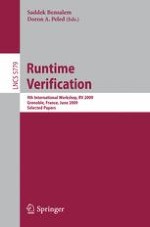2009 | Buch
Runtime Verification
9th International Workshop, RV 2009, Grenoble, France, June 26-28, 2009. Selected Papers
herausgegeben von: Saddek Bensalem, Doron A. Peled
Verlag: Springer Berlin Heidelberg
Buchreihe : Lecture Notes in Computer Science
